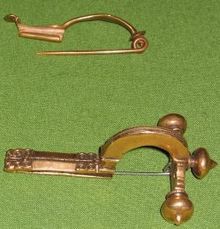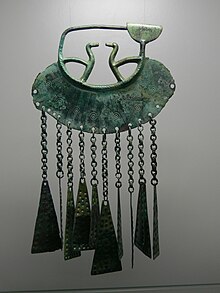Fibula (clasp)




A primer ( latin fibula , clip ',' bolt ',' clip ', buckle', tacking needle ',' Close ' ) is a metal, the principle of the safety pin corresponding dress pin , the oldest detected shapes from the Bronze originate and were used until the high Middle Ages .
function
Brooches were used to hold clothes, cloaks and cloaks together (robe fastening). They peeled off the robe needle . In addition to their practical function, they also served as jewelry and could be provided with pendants ( pendilies ). They were often also symbols (e.g. badges of rank ) or were supposed to ward off disaster with special ornamentation as a lucky charm . They consist of a needle and a bracket or blanket. The oldest fibulae consist of two parts, the younger ones have a needle and a bracket connected by a springy spiral or a hinge . It can best be compared to a brooch or safety pin today . The advantage of the fibula over the previously used needle was that the closable fibula did not slip out of clothing so easily and - depending on the design - a protrusion over the needle tip reduced the likelihood of injuries. Brooches were partly replaced by buckles in ancient times . With the advent of the button , they went completely out of style.
construction
One can basically differentiate between hinge and spiral brooches based on the type of locking mechanism. Every primer also includes a needle holder. This is located at the foot of the fibula. The large, visible and often richly decorated part of a fibula is called the bow. The spiral construction is not only found in Roman fibulae, it can also be found in many pre-Roman and medieval fibula types. The hinge brooches, however, are almost exclusively Roman.
Manufacturing
Most fibulae were made from bronze . But there are also finds made of iron , gold or silver . The surfaces of bronze brooches can also be coated with other metals, mostly white metal (i.e. tin), very rarely silver or gold.
Brooches were cast first. For this purpose has been lost wax with lost wax used. This means that the clay molds were destroyed after being used once, i.e. they were lost. After casting, the fibulae were reworked by forging or cold forming (e.g. hammering). Most fibulae were made from one casting. But there are also types of fibulae that consist of several parts and have been soldered together.
The raw fibulae were decorated in a variety of ways. The fibula body can be decorated with dots, stamp decorations, engravings, notches or facets. In addition, there was also the option of inserts and pads on the fibula body. These could consist of sheet metal, glass, non-ferrous metal , pearls, etc.
Occurrence
Brooches were used in the scriptless prehistoric cultures as well as by the Greeks, Romans and Byzantines. The oldest two-part fibulae (e.g. primeval fibulae) have been known since the older Bronze Age . The one-piece construction appeared in the 14th or 13th century BC in the area south of the Alps. Brooches remained in use until the 14th century AD, when they were first replaced by the stick , then the button and buttonhole . As a piece of jewelry, however, it is presumably preserved in the brooch .
Clasps of the type like Latchet (BM 1854,0714.97) occur exclusively in Ireland.
Agraffe
The delimitation of the fibula from the clasp , which occurs in the late Middle Ages and is usually round or four-pass , six-pass or eight-pass-shaped, is not precisely defined . It is used to hold two items of clothing together, is either firmly sewn onto one piece of fabric and hooked into an eyelet attached to the other piece of fabric, or it is hooked on both sides and can be removed from the item of clothing. It serves as a piece of jewelry in spiritual and secular clothing. The green Dresden diamond is part of an agraffe.
Archaeological importance
The temple in particular was designed very differently from region to region and from time to time and was also used as jewelry. As a result, many fibula forms are an important reference point for archaeologists as " key fossils " when dating finds and findings . The large number of found objects with decorative elements typical of the time and region made it possible to set up a complete typology of chronologically successive primer forms.
Terminology and typology (examples)



According to the shape of the fibula, there are many different types of fibula. In many cases, they are named according to the form, for example:
- Eyeglass primers
- Bow brooches
- Drago fibula or dragon fibula
- Elbow brooches (also known as elbow brooches)
- Omega fibulae (provincial roman)
- Disc brooches
- Animal brooches (e.g. bird brooches ).
Details of the construction or the decoration can also be decisive for the naming, cf. about the:
- Eye fibulae
- Thistle brooches
- Buckling brooches
- Fibula prenestina
- Ring brooches
- Beak fibulae
- Bowl fibulae
- Onion button fibulas .
Names according to individual sites or regions are also common:
- Dux brooches to Duchcov , today the Czech Republic
- Hunterstone Brooch , Scotland
- Brooches from Meldorf to Meldorf
- Langton Down brooches for a town in England
- Marzabotto fibula based on Marzabotto
- Münsinger fibulae after the Münsingen-Rain cemetery
- Nauheim primers to Bad Nauheim
- Peschierafibeln to Peschiera del Garda
Naming after the presumed manufacturer of a fibula type:
- Aucissa or Legionnaire's brochures
- Nertomarus fibula .
Sometimes the shapes are named after the structure of the editors; the typological classification of the imperial primers by the Swedish prehistorian Oscar Almgren is known .
The time can also be included in the naming, for example in some forms of the Latène period (e.g. the early La Tène scheme).
Important collections of primers
Important collections of primers can be found in the following museums:
- Roman-Germanic Museum in Cologne : Roman and early Germanic primers
- Hellweg Museum in Geseke : more than 250 medieval fibulae (6th to 13th centuries) from Westphalia
literature
- Oscar Almgren : Studies on Northern European fibula forms of the first centuries AD, taking into account the provincial Roman and southern Russian forms. 2nd edition, supplemented by an afterword. Kabitzsch, Leipzig 1923.
- Hans Appler: The Bronze Age and Iron Age primers of the Old Tyrol region (North, South, East Tyrol, Trentino) with views of neighboring areas. = Brochures from the Bronze and Iron Ages of the Old Tyrolean region with views of neighboring areas (= New archaeological research on prehistory and Roman times in Tyrol. 2). Hans Appler, Wattens et al. 2018, ISBN 978-3-200-05723-4 .
- Judy Birmingham: The Development of the Fibula in Cyprus and the Levant. In: Palestine Exploration Quarterly. Vol. 95, No. 2, 1963, pp. 80-112, doi : 10.1179 / peq.1963.95.2.80 .
- Ulrich Boelicke: The fibulae from the area of the Colonia Ulpia Traiana (= Xantener reports . Vol. 10). von Zabern, Mainz 2002, ISBN 3-8053-2944-X .
- Ertuğrul Caner: Brooches in Anatolia (= prehistoric bronze finds. Dept. 14, Vol. 8). Part 1. Beck, Munich 1983, ISBN 3-406-09015-X .
- Elisabeth Ettlinger : The Roman fibulae in Switzerland (= Handbook of Switzerland for the Roman and Merovingian times. ). Francke, Bern 1973 (also: Bern, University, habilitation paper, 1969).
- Ronald Heynowski: Primers. recognize, determine, describe (= archeology booklet. 1). Deutscher Kunstverlag, Berlin et al. 2012, ISBN 978-3-422-07119-3 .
-
Herbert Kühn : The Germanic bow brooches of the migration period. Academic printing and Publishing house, Graz;
- Part 1: The Germanic bow brooches of the migration period in the Rhine Province. 2nd, improved edition. 1965;
- Part 2: The Germanic bow brooches of the migration period in southern Germany. 2 volumes (Vol. 1: The Basics. Vol. 2: The Results. ). 1974, ISBN 3-201-00406-5 ;
- Part 3: The Germanic bow brooches of the Migration Period in Central Germany. 1981, ISBN 3-201-01149-5 .
- Eckhard Meineke , Rosemarie Müller, Heiko Steuer , Ulrich Zimmermann, Margot Maute-Wolf, Günter Mansfeld, Biba Teržan, Hans-Jürgen Häßler , Kazimierz Godłowski, Hans-Ulrich Voß, Jasper von Richthofen, Astrid Böhme-Schönberger, Lars Jørgensen, Klaus Düwel , Max Martin , Tania M. Dickinson, Egon Wamers , Torsten Capelle : fibula and fibula costume. In: Heinrich Beck u. a. (Ed.): Reallexikon der Germanischen Altertumskunde . Volume 8: Euhemerism - Spruce. 2nd, completely revised and greatly expanded edition. de Gruyter, Berlin et al. 1994, ISBN 3-11-016858-8 , pp. 411-607.
- Friedhelm Pedde: Middle East fibulae. From the Levant to Iran (= treatises of the German Orient Society. 24). Saarbrücker Druckerei und Verlag, Saarbrücken 2000, ISBN 3-930843-57-9 (also: Berlin, Free University, dissertation, 1999).
- Friedhelm Pedde: Development and Extension of Near Eastern Fibulae in the Iron Age. In: Ricardo Eichmann , Hermann Parzinger (Hrsg.): Migration und Kulturtransfer. The change of Near Eastern and Central Asian cultures in the upheaval from the 2nd to the 1st millennium BC. Files of the international colloquium, Berlin, November 23-26, 1999 (= colloquia on prehistory and early history. 6). Dr. Rudolf Habelt, Bonn 2001, ISBN 3-7749-3068-6 , pp. 485-496.
- Friedhelm Pedde: Brooches in graves. In: Ancient Near Eastern Research. Vol. 30, No. 1, 2003, pp. 85-92, doi : 10.1524 / aofo.2003.30.1.85 .
- Johannes A. Potratz: Prehistoric devices. A small primer of forms of prehistoric archeology (= Orion books. 105). Lux, Murnau et al. 1957.
- Jasper von Richthofen: Fibula use - used primers. Studies on primers from the earlier Roman Empire (= Archaeological Reports. 13). Dr. Rudolf Habelt, Bonn 2000, ISBN 3-7749-3010-4 (also: Hamburg, University, dissertation, 1996/1997).
- Emilie Riha: The Roman fibulae from Augst and Kaiseraugst (= research in Augst. 3, ZDB -ID 916720-1 ). With a contribution by Rudolf Fichter and Chrysta Hochhaus. Office for Museums and Archeology of the Canton of Basel-Landschaft, Augst 1979.
- Emilie Riha: The Roman fibulae from Augst and Kaiseraugst. The new discoveries since 1975 (= research in August 18). Römermuseum Augst, Augst 1994, ISBN 3-7151-0018-4 .
- Efi Sapouna-Sakellarakis: The fibulae of the Greek islands (= prehistoric bronze finds. Dept. 14, Vol. 4). Beck, Munich 1978, ISBN 3-406-00773-2 .
- Ernst-Günter Strauss: Studies on the fibula costume of the Merovingian period (= university research on prehistoric archeology. 13). Dr. Rudolf Habelt, Bonn 1992, ISBN 3-7749-2590-9 (also: Kiel, Universität, Dissertation, 1989).
Web links
Individual evidence
- ^ Elisabeth Moses: Agraffe. In: Reallexikon zur Deutschen Kunstgeschichte , Volume 1. Stuttgart 1933, Sp. 216–220 ( online ).



